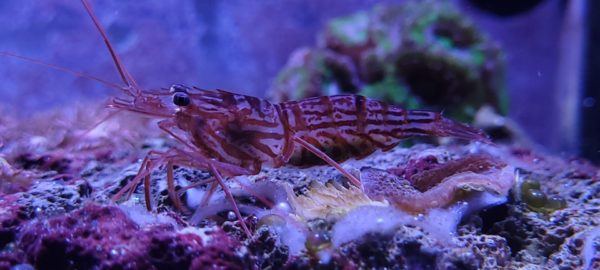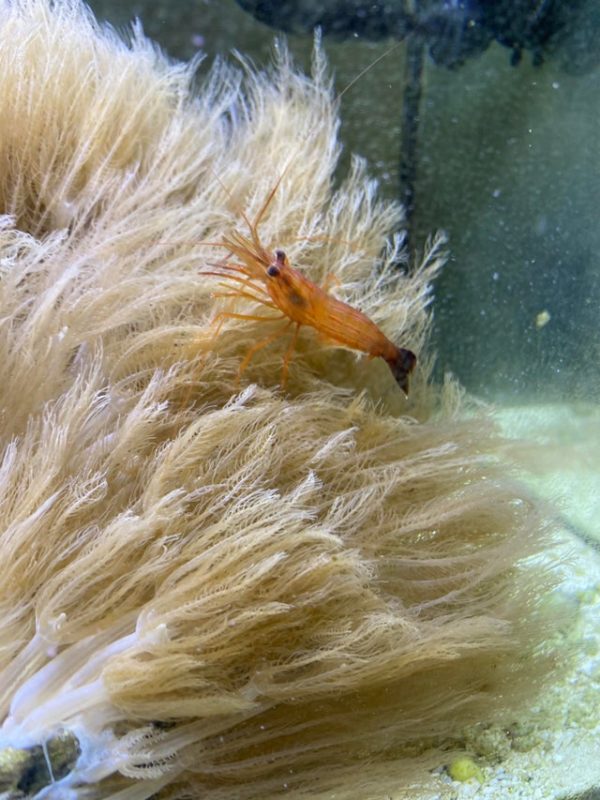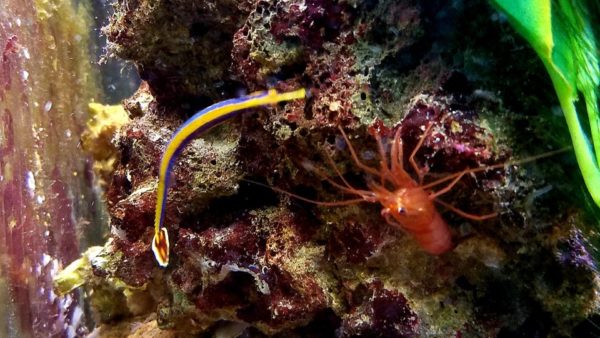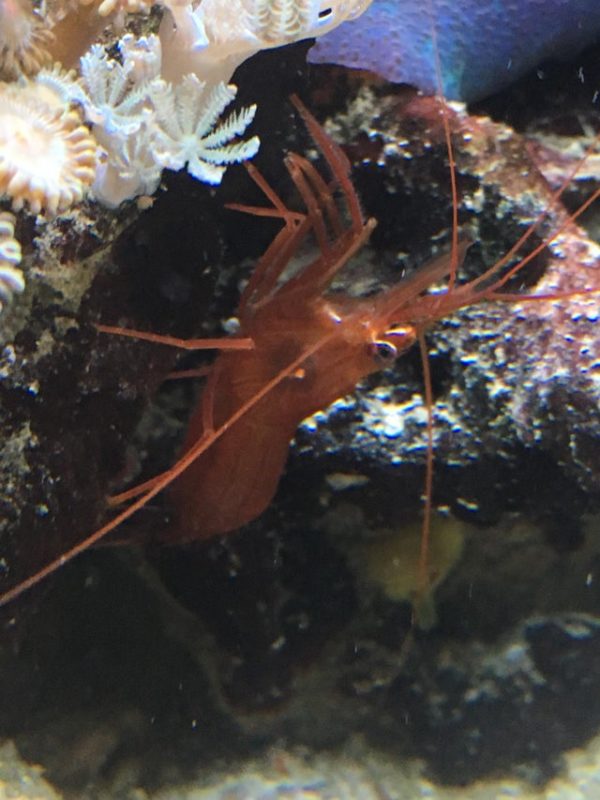We explore Peppermint Shrimp (Lysmata wurdemanni), a low-maintenance, peaceful, and easy-to-care-for species ideal for beginner aquarists. These bright orange, omnivorous shrimps grow up to 2 inches and live for about 2 years. They thrive in saltwater tanks with low currents and are compatible with peaceful tank mates. They’re beneficial for aquariums as they feed on aiptasia and other pests, helping maintain cleanliness.
The guide covers their care, tank setup, feeding habits, behavior, and breeding, ensuring a healthy environment for these fascinating creatures in home aquariums.
When you think about setting up a community tank, you think of setting up one with various fishes and invertebrates. Peppermint shrimps make for an amazing addition to the tank, provided that you know how to take care of them.
This stunning little shrimp should be kept in a saltwater aquarium that does not contain expansive predator anemones. Peppermint Shrimp is commonly known as a sweeper shrimp and keeping it has its advantages. One of which is it will swim around and clean your aquarium.
Peppermint Shrimp eats aiptasia and numerous other pests that affect the general condition of your aquarium. Due to their diet, sweeper shrimp will maintain the cleanliness of your aquarium, thus reducing the need for you to use aquarium pesticides.
Experienced aquarists will tell you that you should add a few species that can clean up the tank from anemones, algae, and food debris on the bottom, and these small shrimps are here to help you with just that.
If you consider adding them to the home aquarium, we have some amazing inputs lined up for you, from their care guide to their breeding habits.
| Information Chart | Peppermint Shrimp |
| Scientific Name | Lysmata wurdemanni |
| Family | Hippolytidae |
| Care level | Easy |
| Temperament | Peaceful (sometimes territorial) |
| Color | Bright orange |
| Lifespan | Up to 2 years |
| Size | 1.5 to 2 inches |
| Diet | Omnivore |
| Minimum Tank size | 5-10 gallons |
| Temperature | 64-72 degrees Fahrenheit |
| Water conditions | Saltwater with low current |
| Tank mate compatibility | Peaceful |
Table of Contents
Peppermint Shrimp Care
The Peppermint Shrimp is incredibly low maintenance and easy to care for. They are, therefore, highly advised for beginners. They get along well with and are calm with other fish in aquariums. You won’t have to go out of your way or incur hefty expenses to take care of them because they are very easy to keep.
Peppermint Shrimp Appearance

Peppermint Shrimp, also known as candy cane or veined shrimp, are recognized for their semi-transparent, light reddish exoskeleton with longitudinal and transverse red bands. Stress can cause them to lose color or turn transparent. They grow up to 2 inches and can be confused with Lysmata Rathbunae, which differs in tail color and stripe visibility. Their appearance can vary depending on environmental factors and species variation.
Also often known as candy cane shrimp or the veined shrimp, the peppermint shrimp generally coins its name from the kind of color they have.
Like the other general shrimps available in the market, these feature a semi-transparent and light reddish exoskeleton. You will also find streaked longitudinal and transverse red bands all over the body.
However, one unique attribute to their appearance is that they tend to lose their color when the shrimps are under stress. Some of them even turn completely transparent in appearance and lose their bright red color.
The mature shrimps can grow up to 2 inches in length, comparable to a lot longer than other shrimp species that aquarists house in their tanks. However, they don’t live very long, which means that you should buy the young, small ones instead of the mature ones that are close to finishing their lifecycle.
Due to the bright color, it can easily be confused with another shrimp species called Lysmata Rathbunae. Differentiation of the two species is very difficult in terms of external appearance. Lysmata Rathbunae has a darker tail, no visible stripes, and a darker body. Another difference is that Lysmata Rathbunae does not feed on aiptasia, whereas Lysmata Wundermanni is a great consumer of such algae.
Lifespan of Peppermint Shrimp
The typical lifespan of a peppermint shrimp is 2-3 years. However, they do inch around living for 1-2 years, in most cases.
However, in rare cases and with optimal and guided care in the home tank, they can eventually live for longer than two years.
Peppermint Shrimp Size
The typical peppermint shrimp size is between 1.5 to 2 inches when they grow into an adult. However, given the rampant popularity of these shrimps compared to the standard aquarium shrimps, they are gaining more value and being sold for an expensive price.
Natural Habitat and Origin
As tropical as the concept of a peppermint shrimp might sound, they did originate from Charleston in South Carolina. Alternatively, they are also found in Key West in Florida. If you had to find them in abundance in their natural habitat, these small shrimps are naturally found along the East Atlantic stretch to the Caribbean Sea.
Given their adaptability and overall structure and functionality, these shrimps are often found along the vertical shafts of the reefs. Some are even found in the pipe sponges just above the wave.
Most experienced aquarists suggest not putting them in a reef tank, mainly because they gobble down small polyps and soft corals without any control. Some people have even complained about witnessing the same when they put the shrimps in the tank.
However, you need to realize that whether they will chomp down on the corals in the tank depends on the kind of Lysmata species you are housing. Make sure you ask the professional breeder about the same before buying them. The standard Peppermint shrimp or the Lysmata wurdemanni are reef safe, while the Atlantic peppermint shrimps aren’t.
Peppermint Shrimp Care and Tank Setup
Peppermint Shrimp require a saltwater tank with stable conditions and a minimum size of 20 gallons. The setup should include live rock for hiding and grazing. Good water quality, stable temperature, and specific gravity are crucial for their health. They thrive in environments that mimic their natural habitat, with a moderate water current and ample space to roam. Regular maintenance of the tank, including monitoring water parameters and cleanliness, ensures a healthy environment for these shrimps.
Although they aren’t diurnal, the peppermint shrimp is generally the most active during the night when the lights are dimmed. They are extremely easy to care for, so you won’t have to go out of your way to sort things out with extreme expenses.

They adjust effortlessly, so they don’t stress over an excessive number of issues concerning the water conditions.
The Peppermint Shrimp is best suited to a marine aquarium with live stone, plenty of hiding places, and open spaces to look for food. They are nocturnal creatures and rarely can be seen during the day as they are hiding from predators. But at night, they go out of hiding in search of food.
Peppermint shrimps are very friendly and peaceful to other aquarium inhabitants. Attention, it seems to be biting from coral, so it is recommended to keep yourself in a marine aquarium only with fish and not in a reef type.
While we discuss things in brief, let us dive more into the individual aspects of the tank set-up and care:
Peppermint Shrimp Tank Size and Specifications
The Peppermint Shrimp (Lysmata Wurdemanni) is best known for its ability to clean the anemone. Although it is considered an important member of the “clean-up crew” (CUC) – the aquarium cleaning team, it is more of a creature that feeds detritus, food debris, and decomposing organic material.
For this reason, maintaining the right care and setup in the tank is a lot more important than you’d anticipate.
Optimum Tank Size for Peppermint Shrimp
We’d recommend starting with a reef tank, especially if you consider keeping multiple Peppermint shrimps in them. Those mimic the natural habitat better and give them a comfortable life.
The minimum recommended tank size for Peppermint Shrimp starts from 5 gallons. Yes, that’s how accommodating they are. However, if you put them in a community tank, you’d generally have to put them in a larger tank and switch up the settings according to their comfort.
Filter Type
Unlike fishes that require a steady water current to live comfortably in the tank, you can’t expect the same with the peppermint shrimp. You can’t especially expect the tank to have a high-power filtration because that is what causes most of the complications.
If the filtration is too heavy or too powerful, it will end up sucking in the shrimps, causing them to die a painful death. Also, this is more common in smaller tanks with a tight space.
Low rise water current with steady water flow is considered ideal for the tank housing peppermint shrimp.
Substrate
Peppermint shrimps aren’t demanding with their surroundings. You can keep them in a tank with rocks as substrate, and they will be happy with it. Just ensure that you plant in enough hiding spots for them, and you should be good.
How many Peppermint Shrimp in a 20-gallon tank?
Since peppermint shrimps don’t take up much space, you can easily house 5-6 of them in a 20-gallon tank. However, always make sure they have their individual space in the tank to prevent them from becoming territorial quickly.
Water Parameters for Peppermint Shrimp
Peppermint shrimps are very adaptable to the water conditions they are put in, so they are considered ideal for beginners. However, just because they are undemanding doesn’t mean that you can just chuck them in a tank of water with no precautions. There are a few water parameters that should be taken care of.
Water Temperature
The ideal water temperature for Peppermint Shrimp is between 64–72-degree Fahrenheit, which is a lot cooler than you’d anticipate. So, if you are keeping them in a community reef tank with other fishes and invertebrates, you need to ensure that the other inhabitants are comfortable with that temperature.
pH Level
The perfect water pH level for Peppermint Shrimp is 8.1 to 8.4. This means that they ideally stay comfortable in alkaline water conditions.
Water hardness
The water hardness in the tank should be between 8-12 dKH.
Peppermint Shrimp Tank Landscape
Although peppermint shrimps are quite shy and don’t get into a commotion inside the tank, you will often find them fighting for their territory if too many are clubbed in a tight space.

Try to keep two of them in a 10-gallon tank and then increase the size of the tank by 5-gallons for each additional shrimp that you house. This way, they have enough space to move around, and you won’t have to worry about any signs of aggressiveness.
However, when setting up the tank, you need to decide which species of peppermint shrimp you have. If it is the standard one, you can keep them in the reef aquarium. Besides that, you have to house them in the standard home aquariums.
Whatever the choice be, maintain the water parameters as discussed in the section above. As for the landscape, rocks and gravels make for the best substrate for these invertebrates.
Besides that, you should also keep multiple hiding spots and open places in the tank where these shrimps can hide away or go in search of food in case they are hungry. Also, although they aren’t shoaling groups, keeping them alone can put them under a lot of stress.
So, try to keep them in a group of 4-5 in the tank. Another factor that you need to be mindful of when prolonging the lifespan of these small shrimps is stability. If you are consistently changing water, changing the setup, and their tank mates, it can put a lot of pressure on them.
Also, besides a low-power filter and water pump, make sure that you keep the tank clean now and then to rid the rising ammonia or nitrate levels in the tank. Besides the graveled substrate, you also need to keep some plants in the tank as well. Both live and fake plants get the job done.
As for lighting in the tank, you need to keep it switched on during the day and then switched off at night to let them have a comfortable time in the tank.
Feeding Peppermint Shrimp
Like other invertebrates, Peppermint shrimp does not tolerate large nitrate and copper levels and changes in water parameters. Because it plucks the shell, it needs iodine supplements to help in this process. Like food, it consumes aiptasia, although it prefers to consume smaller anemones than big ones. If it does not have enough food sources, you can supplement the diet with food or fresh fish.

They can feed on granules and flakes that they will search for on the bottom of the aquarium, through the substrate, and consume Aiptasia anemones, but if they are too large, shrimp will ignore them. They are known to feed on dead fish tissues, so they are useful in cleaning them; they will even eat dead skin particles from the human hand.
You will soon realize that these peppermint shrimps have two jobs throughout the day – they are either hiding away under the tank or rock ledges, or they are feeding on the bottom of the tank or the anemones that grow inside.
Housing peppermint shrimp is quite easy because they aren’t always dependent on you for the food and will roam around the tank in search of the same. But, that doesn’t mean that you won’t have to feed them anything extra now and then. Sinking pellets and fresh fish pieces are often considered good food for their appetite.
Sometimes, if you find these shrimps not doing their job of eliminating the aiptasia anemones from the tank, it is better that you add a few more to check if that works.
Peppermint Shrimp Behavior and Temperament
If you’re considering getting peppermint shrimp for your aquarium, keep in mind that you may want to get only a few individuals in a large tank or just one for a smaller tank because they tend to become very aggressive with each other. Their tank size ought to be at least ten gallons.
They aren’t necessarily bottom dwellers, but they are bottom feeders, which means that they will navigate to the bottom of the tank in search of food. You will also often find them sifting through the sand or oscillating in the middle of the tank.
Also, unless you are packing in many peppermint shrimps in a smaller tank, you won’t have to worry about the risks of aggression. When the space is limited, they start attacking the other fishes and shrimps nearby.
Another standout feature worth noting in them is that they are nocturnal species. They will gobble down most of their feeding during the nighttime. So, if you can’t seem to find them around the tank during the daytime, it is probably because they are hiding out in the tank.
Peppermint Shrimp Tank Mates
Peppermint shrimps are often added to the tank aquariums as a cleaner, but aquarists have found that they aren’t ideal, especially when it comes to the anemones.

But, one good thing about housing peppermint shrimp is that they aren’t fighting starters. They like to keep to themselves, which is why they are ideal for beginner aquarists.
When it comes to ideal tank mates, try to pair them in a tank with saltwater fishes that can stay in alkaline water conditions. Moreover, avoid putting them with larger fish because they would end up being snacks.
Breeding Peppermint Shrimp
Peppermint shrimp are a hermaphrodite type of shrimp, individuals having both male and female sexual organs, and they can replicate rather quickly. Mating happens regularly after the shrimp have shed, laying a small number of eggs that in the beginning they will be blue, and after around 12 days, they will swing to a silver-like color, which shows they are prepared for hatching. They will hatch once they have turned silver, and they will hatch at night, and after that, the little shrimps will swim towards the light.
Having peppermint shrimps in your aquarium is, for the most part, simple to deal with. They eat the Aiptasia anemones that develop in the aquarium and other ailing tissues and things of that comparing. They require a temperature of 70 degrees and can be housed with other Peppermint shrimps (5 gallons for each shrimp.) As well as some other kinds of fish will not be chased and eaten by any other fish; rare cases may occur with some aggressive fish species.
Peppermint shrimp are pretty and will add some pleasant shading to your aquarium and keep it clean in the meantime.
Peppermint Shrimp Diseases and Treatment
When it comes to the risks of diseases in the peppermint shrimp, it all comes down to the kind of breeder you are getting them from. They are more likely to be under stress if they aren’t bred with proper measures and not grown in the ideal water parameters.
Stress is hands down one of the biggest issues with these invertebrates. Besides that, you will often find them infected with bacterial or parasitic infections, but those are quite rare. Overeating can also put them under stress.
So, while housing them, you need to be mindful of all these factors and even quarantine them in another tank before introducing them to the main tank.
Are Peppermint Shrimp Right for You?
If you are tired of housing just fishes in your reef or normal tank and want a change in scenery, peppermint shrimps are the best choice. They are easy to maintain, can often feed themselves, and don’t require much attention and care. Once you maintain optimal living conditions, you won’t have to go out of your way to do anything more.

So, if you plan to introduce some types of invertebrates to the tank, these are ideally your best choice.
FAQs
Are peppermint shrimp reef safe?
The standard peppermint shrimp is reef safe; however, the Atlantic peppermint shrimps aren’t and will bite down and chew on the remnants of the corals in the tank they are kept in.
How often do peppermint shrimp shed?
The peppermint shrimp shed their shell once a week when they are young. And, the following few days after the shedding, you will find them hiding away in the tank until their shell hardens from the outside. Once they start growing more and become full-blown adults, the molting process happens every ten days to two weeks.
What does a pregnant peppermint shrimp look like?
Most peppermint shrimps stay pregnant for up to 20 days. While they stay their standard color during pregnancy, they become more silvery and transparent when the eggs are about to be laid and hatched.
Which fishes eat peppermint shrimp?
Although peppermint shrimps are quite good at hiding out from their predators, there is always a risk of them getting eaten by the larger fishes like wrasse or puffer, so make sure you don’t put them in such community tanks.
Will peppermint shrimp eat parasites?
Yes, the peppermint shrimps are often added to tanks because they habit nibble off the skin of the fish parasites in the tank.
Do peppermint shrimp come out at night?
Yes, they are nocturnal, which means that they are more active during the nighttime. You will often find the shrimps coming out of their hiding spot at night, exploring the tank, and then moving ahead and scrounging for food in the tank.
Can you keep peppermint shrimp with cleaner shrimp?
As long as you house them in a larger tank with enough space for each shrimp to swim around and hide when they need, there shouldn’t be any problem or conflict.
Conclusion
It is a shrimp that many people will look for because of its beautiful appearance; it is useful in the aquarium because it helps clean it and can also clean the fish of dead epithelial tissues. If more than two individuals are in the aquarium, they can become aggressive. It is recommended not to keep you together with aggressive fish species.
They are recommended for beginner saltwater shrimp keepers because they are easy to look after and undemanding. If you are breeding for sale, you can get a good value for them.
We hope this guide gives you all the details that you needed to know about taking care of peppermint shrimp and housing them in your home aquarium. If you have further queries, make sure you leave them for us in the comments.
No related posts.
